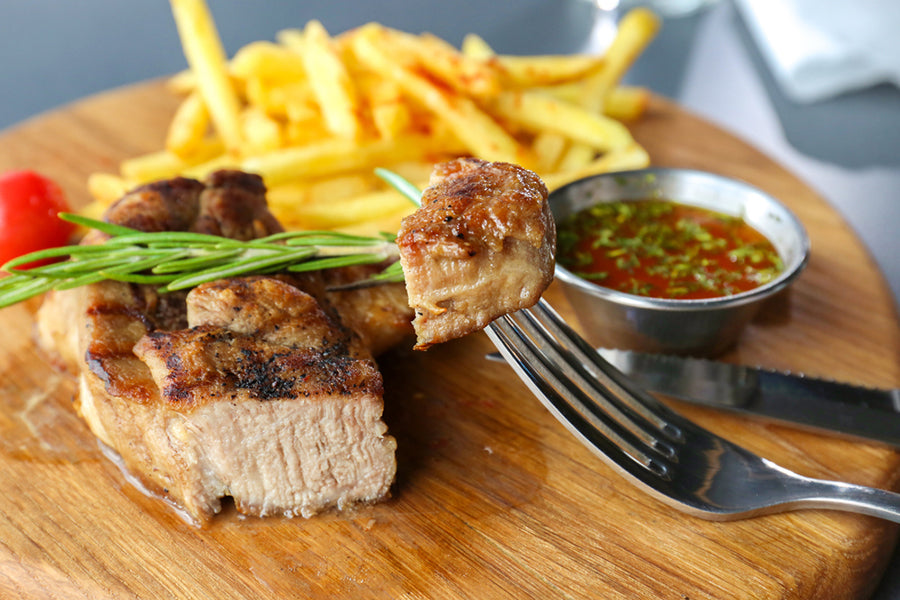Steak is the one food that always seems to hit the spot, no matter the occasion. Whether you're celebrating something special or simply treating yourself to a delicious meal, steak always seems to fit the bill. But why is steak so famous? Is it the taste? The texture? The versatility? Whatever the reason may be, steak is always the most popular choice when it comes to meat.
The steak's beauty, flavor, and tenderness lie in the meat cut that is used to make it. There are different cuts used for making steak, including sirloin, which is one of the best cuts for a steak besides eye filet, rump, T-bone, and scotch filet.
The sirloin is a popular cut from the rear back part of the cow. It comes in two parts: top sirloin and bottom sirloin, with the former being more tender than the latter, which can be called simply 'sirloins.' Both these types are great for grilling or sautéing due to their ability to absorb flavor during the cooking process while still maintaining juiciness when done right.
Also, sirloin has high protein and low-fat content, making it an even better option if you have started eating healthy. It is especially beneficial to those trying to lose extra pounds as proteinaceous meals are often recommended for weight loss.
So, why not share a super delicious sirloin steak recipe and its benefits? If you're in the mood for something hearty and satisfying, be sure to give this steak recipe a try. You just might be surprised by how much you enjoy it!
Related Article: High Protein: Best Epic Breakfast Burrito Recipe
Sirloin Steak With Garlic Butter
The ingredients used in this recipe are readily available and are beneficial to the human body. It is quick to prepare, so you can enjoy both taste and nutrition.
Nutritional Facts
Serves 8 people
|
Carbohydrates |
1.2 g (4.8 cal) |
|
Protein |
37.7 g (150.8 cal) |
|
Fats |
32.2 (289.8 cal) |
|
Cholesterol |
151.4 mg |
|
Sodium |
166.8 mg |
|
Potassium |
508.9 mg |
|
Iron |
2 mg |
|
Calcium |
21.5 mg |
|
Vitamin A |
354 IU |
|
Total Calories |
446.76 cal |
Time Required
|
Preparation Time |
20 Minutes |
|
Cooking Time |
10 Minutes |
|
Total Time |
30 Minutes |
Ingredients
- ½ cup butter
- 2 teaspoons of garlic powder
- 4 cloves garlic, minced
- 4 pounds beef top sirloin steaks
- Salt and pepper (as required)
Directions to Cook
- Preheat an outside grill to high heat and brush it gently with oil.
- On medium-low heat, melt butter in a small saucepan and add the minced and powdered garlic, and set it aside.
- Season each steak thoroughly with salt and pepper on both sides.
- Cook the steaks for 4-5 minutes per side on a hot grill. An instant-read thermometer inserted into the steak’s center should read 140 degrees F (60 degrees C) for medium doneness.
- Brush the tops of the steaks with garlic butter and rest for 2-3 minutes before serving.
Benefits of Sirloin Steak
Steak is a delicious and versatile type of red meat that can be cooked in various ways and is a good source of protein, iron, and other nutrients, making it an excellent option for a nutritious meal. It can be grilled, roasted, or pan-fried, allowing you to choose the cooking method that best suits your taste. Also, it has some healthy fats, which can help to keep you feeling full and satisfied after a meal. Down below are some of the benefits of sirloin steak ingredients:
Excellent Protein Source
Red meat, including beef, is the best protein source and a vital energy provider after carbohydrates. This macronutrient is involved in metabolic reactions and immunological responses, supplies energy, aids in cellular repair and helps create blood cells.
According to a study, animal meat has all the nine essential amino acids that the human body cannot produce and should be taken from food sources. These amino acids are the building blocks of proteins, and their profile in meat is similar to human muscles. That is why eating meat may be beneficial especially after a surgery or for recovering athletes, as it assists in the maintenance and growth of muscle mass combined with strength training.
Related Article: Every Lifter Should Know These 7 Facts About Essential Amino Acids
Provides Healthy Low Fat
Beef fat, commonly known as beef tallow, is found in variable proportions in different cuts of beef. Fat boosts the calorie content of meat in addition to increasing flavour. Sirloin is a leaner cut with extremely little fat content, as lean meat contains roughly 5–10 percent fat content.
Also, according to a study, ruminant trans fats are found in food products from ruminant animals such as cows and sheep. Organic ruminant trans fats, unlike their industrially manufactured equivalents, are not considered harmful.
Prevents Anemia
Anemia is a common disorder caused by a reduced number of red blood cells and a decreased blood ability to transport oxygen. One of the most prominent causes of anemia is an iron deficiency, with tiredness and weakness as the most common symptoms.
Fortunately, iron is abundant in red meat, mainly in the form of heme iron. The body easily absorbs heme iron than non-heme iron, found in plant-based meals. It means it not only contains a bioavailable type of iron but also increases the uptake of non-heme iron from plant diets, a mechanism known as the "meat factor" that has yet to be fully explained.
Another study discovered that meat supplements are more beneficial than iron tablets at keeping women's iron levels stable throughout exercise.
Packed With Micronutrients
Steak meat is packed with micronutrients, including vitamins and minerals. These micronutrients are essential for immunity, blood clotting, and other functions. According to a study, meat is a good source of selenium, which is a crucial trace element that helps your body perform many processes.
Niacin (vitamin B3) has a variety of roles in your body and is present abundantly in meat. According to a study, its deficiency has been linked to a higher risk of heart disease. Zinc is also present in beef, which is necessary for body growth and upkeep.
Not only these micronutrients, beef also has vitamin B12, vitamin B6, phosphorus, and iron.
Related Article: The Benefits of Multivitamins: 8 Surprising Reasons to Take Them
Improves Workout Performance
Red meat such as beef can improve your exercise performance with numerous macro and micronutrients. Also, it has some additional substances like carnosine, which increases exercise performance.
Carnosine is a muscle-functioning molecule made in the body from beta-alanine, a dietary amino acid present in large amounts in fish and meat, notably beef. A study indicates that high doses of beta-alanine for about 4–10 weeks have been proven to boost carnosine levels in muscles by 40–80%. High amounts of carnosine in human muscles have been related to less tiredness and better exercise performance.
Wrapping Up
Sirloin steak with garlic butter is a delicious meal, especially for meat lovers. The recipe is easy to make with readily available and simple ingredients. It is an excellent source of proteins, fats, vitamins, and minerals with numerous benefits, such as preventing anemia, improving workout performance, and enhancing muscle building, ettc. All these nutrients improve your overall health and make you stronger.
So, what are you waiting for? Get the ingredients, heat the grill, and have a tasty sirloin steak with your family tonight!
Reading list
Article Sources
- Derave, Wim, et al. “Beta-Alanine Supplementation Augments Muscle Carnosine Content and Attenuates Fatigue during Repeated Isokinetic Contraction Bouts in Trained Sprinters.” Journal of Applied Physiology (Bethesda, Md.: 1985), vol. 103, no. 5, Nov. 2007, pp. 1736–43. PubMed, https://doi.org/10.1152/japplphysiol.00397.2007.
- Lyle, R. M., et al. “Iron Status in Exercising Women: The Effect of Oral Iron Therapy vs Increased Consumption of Muscle Foods.” The American Journal of Clinical Nutrition, vol. 56, no. 6, Dec. 1992, pp. 1049–55. PubMed, https://doi.org/10.1093/ajcn/56.6.1049.
- Rayman, Margaret P. “Selenium and Human Health.” Lancet (London, England), vol. 379, no. 9822, Mar. 2012, pp. 1256–68. PubMed, https://doi.org/10.1016/S0140-6736(11)61452-9.
- Sale, Craig, et al. “Effect of Beta-Alanine Supplementation on Muscle Carnosine Concentrations and Exercise Performance.” Amino Acids, vol. 39, no. 2, July 2010, pp. 321–33. PubMed, https://doi.org/10.1007/s00726-009-0443-4.
- Schmid, A., et al. “Conjugated Linoleic Acid in Meat and Meat Products: A Review.” Meat Science, vol. 73, no. 1, May 2006, pp. 29–41. PubMed, https://doi.org/10.1016/j.meatsci.2005.10.010.
- Valenzuela, Carolina, et al. “Total Iron and Heme Iron Content and Their Distribution in Beef Meat and Viscera.” Biological Trace Element Research, vol. 132, no. 1–3, Dec. 2009, pp. 103–11. PubMed, https://doi.org/10.1007/s12011-009-8400-3.
- Williamson, C. S., et al. “Red Meat in the Diet.” Nutrition Bulletin, vol. 30, no. 4, Dec. 2005, pp. 323–55. DOI.org (Crossref), https://doi.org/10.1111/j.1467-3010.2005.00525.x.
- Wyness, L., et al. “Red Meat in the Diet: An Update: Red Meat Update.” Nutrition Bulletin, vol. 36, no. 1, Mar. 2011, pp. 34–77. DOI.org (Crossref), https://doi.org/10.1111/j.1467-3010.2010.01871.x.











